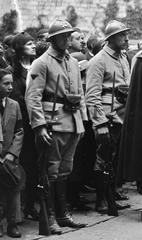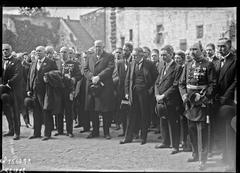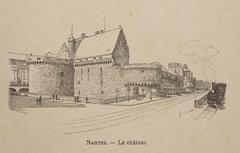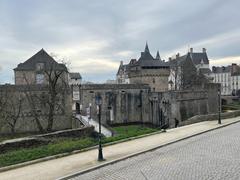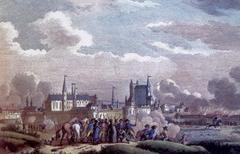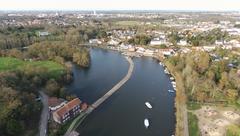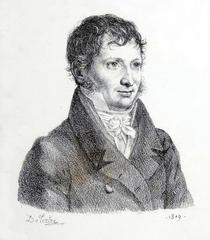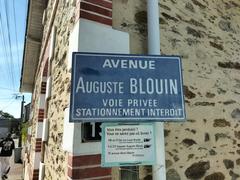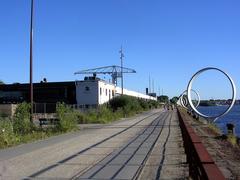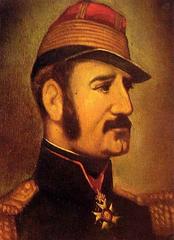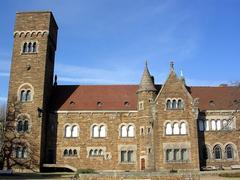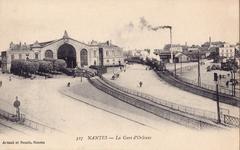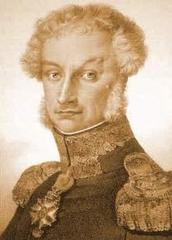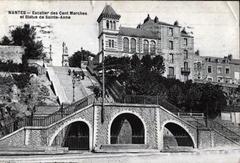
Visiting Hours and Tickets for Château des Ducs de Bretagne, Nantes
Date: 31/07/2024
Introduction
Nestled in the heart of Nantes, France, the Château des Ducs de Bretagne stands as a monumental relic of medieval and Renaissance architecture. This comprehensive guide aims to unravel the rich history, architectural splendor, and practical visitor information of this iconic site to ensure a rewarding experience for all potential visitors. The Château des Ducs de Bretagne is not just a historical monument; it is a cultural gem that offers a fascinating journey through time, from its origins in the 13th century to its modern-day role as a museum and cultural venue (source). Whether you are a history enthusiast or a casual traveler, this guide will provide you with all the essential information, including visiting hours, ticket prices, guided tours, and travel tips to make the most of your visit.
Table of Contents
- Introduction
- Historical Background
- Visitor Information
- Nearby Attractions
- FAQs
- Conclusion
- Call to Action
Exploring the Château des Ducs de Bretagne: History, Visitor Information, and Travel Tips
Introduction
Discover the historical and cultural gem of Nantes, France—the Château des Ducs de Bretagne. This article delves into its rich history, architectural marvels, and essential visitor information to help you make the most of your visit to this iconic site.
Historical Background
Origins and Early History
The Château des Ducs de Bretagne, located in Nantes, France, has a rich history dating back to the 13th century. The first ducal castle was constructed on the remnants of a Gallo-Roman wall, a testament to the ancient roots of the site (source). This initial structure was built by the Namnetes people, who settled in the area. The castle was later demolished in the 15th century to make way for the current building, commissioned by Francis II, the last Duke of an independent Brittany.
Construction and Architectural Evolution
Francis II aimed to create a dual-purpose structure: a military fortress to defend against the French King and a principal residence for the ducal court (source). The castle’s construction was continued by his daughter, Anne of Brittany, who was twice Queen of France through her marriages to Charles VIII and Louis XII. Her influence is evident in the Renaissance-era loggias and the sculptural décor, including dormer windows and the coat of arms on the ‘Golden Crown’ tower (source).
Integration into the French Monarchy
Following the integration of Brittany into France in 1532, the Château des Ducs de Bretagne became the residence of the French monarchy when they visited Brittany. This period marked a significant transformation for the castle, as it transitioned from a ducal fortress to a royal residence. The castle hosted several French kings, including Henri II and Catherine de Médicis in 1551, and Charles IX and Catherine de Médicis in 1565 (source).
Military and Administrative Uses
During the 16th and 17th centuries, the castle underwent numerous changes, serving various military and administrative purposes. It became a military barracks, an arsenal, and even a prison. The castle endured significant damage during this time, including fortifications, a fire in 1670, and an explosion in 1800 (source). Despite these challenges, the castle remained a symbol of power and authority in the region.
Restoration and Modern Use
The Château des Ducs de Bretagne was listed as a historical monument by the French Ministry of Culture in 1840 (source). In 1915, the government sold the castle to the City of Nantes, and it became a municipal museum in 1924. During World War II, the occupying German forces built a bunker in the courtyard, adding another layer to its complex history (source).
Recent Restoration Efforts
Starting in the 1990s, the town of Nantes undertook a massive restoration program to return the site to its former glory. This included restoring the Jacobins’ Tower, the façades of the Principal Governor’s Palace, and the Golden Crown Tower. The Military Saddlery was refurbished in 1997 for temporary exhibitions (source). The most extensive restoration work focused on the white tufa façades of the main ducal residence, which were restored to their full glory. The interior of the ducal residence was also completely redeveloped to house the Nantes History Museum.
The Nantes History Museum
The museum, which opened in 2007 after 15 years of restoration work, now occupies 32 rooms within the castle. It presents over 850 objects, using multimedia devices to offer a modern vision of the city’s heritage. The museum aims to present the past, present, and future of Nantes, making it a vital cultural institution in the city (source).
Symbolic Significance
Despite its varied uses over the centuries, the Château des Ducs de Bretagne remains a symbol of the ducal period of Brittany. A statue of Anne of Brittany, created by Jean Fréour, stands at the entrance to remind visitors of her significant role in the castle’s history (source). The castle’s name, popularized by the writer Marc Elder in 1923, reflects its historical importance and connection to the Dukes of Brittany.
Visitor Information
Accessibility and Opening Hours
The Château des Ducs de Bretagne is accessible to everyone, with free access to the courtyard and fortification walls from 8:30 am to 8:00 pm. The castle interiors, museum, and exhibitions are open from 10:00 am to 7:00 pm (source). The site is well-connected by public transport, including tramway and busway lines, making it easy for visitors to explore this historical gem.
Ticket Prices
Admission fees vary depending on the type of visit. General admission to the museum is around €8, with concessions available for students, seniors, and groups. Free entry is offered on the first Sunday of each month and for children under 18 (source).
Special Events and Guided Tours
The Château des Ducs de Bretagne hosts various events throughout the year, including historical reenactments, exhibitions, and cultural festivals. Guided tours are available in multiple languages, offering in-depth insights into the castle’s history and architecture. Booking in advance is recommended, especially during peak tourist seasons (source).
Photographic Spots and Travel Tips
Photographers will find numerous picturesque spots within the castle grounds, including the moat, rampart walk, and the ‘Golden Crown’ tower. For the best experience, visit early in the morning or late afternoon to avoid crowds and capture the best light. Comfortable shoes are recommended for exploring the extensive grounds.
Nearby Attractions
While visiting the Château des Ducs de Bretagne, be sure to explore other nearby attractions in Nantes. The Machines of the Isle of Nantes, the Jardin des Plantes, and the Nantes Cathedral are all within walking distance and offer additional historical and cultural experiences.
FAQs
What are the opening hours?
The courtyard and fortification walls are open from 8:30 am to 8:00 pm. The castle interiors, museum, and exhibitions are open from 10:00 am to 7:00 pm.
Are there guided tours available?
Yes, guided tours are available in multiple languages. Booking in advance is recommended.
What are the ticket prices?
General admission to the museum is around €8, with concessions available. Free entry is offered on the first Sunday of each month and for children under 18.
Conclusion
The Château des Ducs de Bretagne stands as a testament to the rich and complex history of Nantes and Brittany. Its transformation from a ducal fortress to a royal residence, military barracks, and finally a museum, reflects the dynamic history of the region. The castle’s architectural beauty, combined with its historical significance, makes it a must-visit destination for anyone interested in the heritage of France.
Call to Action
For more information and updates, download the Audiala app, check out our related posts, and follow us on social media. Plan your visit today and immerse yourself in the history and culture of the Château des Ducs de Bretagne!
